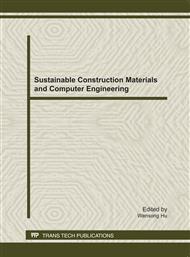[1]
C. F. Ying and R. Truell, Scattering of a Plane Longitudinal Wave by a Spherical Obstacle in an Isotropically Elastic Solid, Journal of Applied Physics, vol. 27, pp.1086-1097, (1956).
DOI: 10.1063/1.1722545
Google Scholar
[2]
D. E. W. Stone and B. Clarke, Ultrasonic attenuation as a measure of void content in carbon-fibre reinforced plastics, Non-Destructive Testing, vol. 8, pp.137-145, (1975).
DOI: 10.1016/0029-1021(75)90023-7
Google Scholar
[3]
B. G. Martin, Ultrasonic attenuation due to voids in fibre-reinforced plastics, NDT International, vol. 9, pp.242-246, (1976).
DOI: 10.1016/0308-9126(76)90004-3
Google Scholar
[4]
B. G. Martin, Ultrasonic wave propagation in fiber-reinforced solids containing voids, Journal of Applied Physics, vol. 48, pp.3368-3373, (1977).
DOI: 10.1063/1.324176
Google Scholar
[5]
J. M. Hale and J. N. Ashton, Ultrasonic attenuation in voided fibre-reinforced plastics, NDT International, vol. 21, pp.321-326, (1988).
DOI: 10.1016/0308-9126(88)90190-3
Google Scholar
[6]
E. A. Birt and R. A. Smith, A review of NDE methods for porosity measurement in fibre-reinforced polymer composites, Insight, vol. 46, pp.681-686, (2004).
DOI: 10.1784/insi.46.11.681.52280
Google Scholar
[7]
D. K. Hsu and S. M. Nair, Evaluation of porosity in graphite-epoxy composite by frequency dependence of ultrasonic attenuation, in Review of Progress in Quantitative Nondestructive Examination, New York, 1987, pp.1175-1184.
DOI: 10.1007/978-1-4613-1893-4_135
Google Scholar
[8]
Z. Guerdal, A. P. Tomasino, and S. B. Biqqers, Effects of processing induced defects on laminate response: Interlaminar tensile strength, SAMPE Journal, vol. 27, pp.39-49, (1991).
Google Scholar
[9]
I. M. Daniel, S. C. Wooh, and I. Komsky, Quantitative porosity characterization of composite materials by means of ultrasonic attenuation measurements, Journal of Nondestructive Evaluation, vol. 11, pp.1-8, (1992).
DOI: 10.1007/bf00566012
Google Scholar
[10]
H. Jeong, Effects of Voids on the Mechanical Strength and Ultrasonic Attenuation of Laminated Composites, Journal of Composite Materials, vol. 31, pp.276-292, February 1, 1997 (1997).
DOI: 10.1177/002199839703100303
Google Scholar
[11]
L. Lin, X. Zhang, J. Chen, Y. F. Mu, and X. M. Li, A morphology-dependent model applied to predict void content of composites based on ultrasonic attenuation coefficient: Random Void Model, Applied Physics A: Materials Science & Processing. DOI: 10. 1007/s00339-010-6061-x, (2010).
DOI: 10.1007/s00339-010-6061-x
Google Scholar
[12]
Y. F. Mu, X. Zhang, L. Lin, H. T. Tian, G. P. Guo, and X. M. Li, Investigations on CFRP Porosity by Using Ultrasonic Testing Based on Random Pores Model, Journal of Mechanical Engineering, vol. 46, pp.22-26, (2010).
DOI: 10.3901/jme.2010.04.022
Google Scholar
[13]
L. T. Ikelle, S. K. Yung, and F. Daube, 2-D random media with ellipsoidal autocorrelation functions, Geophysics, vol. 58, pp.1359-1372, (1993).
DOI: 10.1190/1.1443518
Google Scholar
[14]
R. S. Schechter, H. H. Chaskelis, R. B. Mignogna, and P. P. Delsanto, Real-Time Parallel Computation and Visualization of Ultrasonic Pulses in Solids, Science, vol. 265, pp.1188-1192, (1994).
DOI: 10.1126/science.265.5176.1188
Google Scholar
[15]
D. Z. Wo, Encyclopedia Of Composites. Beijing: Chemical Industry Press, (2002).
Google Scholar
[16]
M. R. Wisnom, T. Reynolds, and N. Gwilliam, Reduction in interlaminar shear strength by discrete and distributed voids, Composites Science and Technology, vol. 56, pp.93-101, (1996).
DOI: 10.1016/0266-3538(95)00128-x
Google Scholar
[17]
A. A. Goodwin, C. A. Howe, and R. J. Paton, The role of voids in reducing the interlaminar shear strength in RTM laminates, in Proceedings of ICCm-11, 1997, pp.11-19.
Google Scholar
[18]
S. R. Ghiorse, Effect of void content on the mechanical properties of carbon/epoxy laminates, SAMPE Quarterly, vol. 24, pp.54-59, (1993).
Google Scholar


